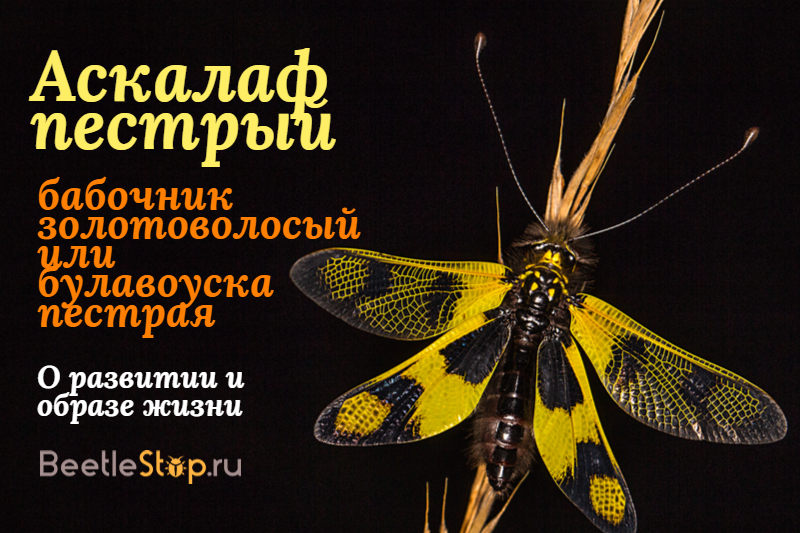Ascalaf motley - a winged predator at the forest edges
Ascalaphidae (Ascalaphidae) is a small family of retinal-winged insects, uniting 400 species. They are distributed around the world, in Europe there are 15 species. New World insects are characterized by activity at dusk - at sunset or dawn. Ascalafs living in Europe are daytime predators. These species are brightly colored, wings fold, imitating dragonflies. The closest relative of insects is the ant lion. Ascalaf motley represents his family in Eastern Europe and Central Asia. Insects can be found in sunny forest glades in the Crimea.

View description
Ascalaf variegated (Libelloidesmacaronius), golden-haired bosnar or variegated mace - representative of the Ascalaf family, retina winged. The body length of adults is 16-30 mm, the wingspan is 35-55 mm. The head is large, complex facet eyes occupy most of it. Forehead and crown in dense hairs. The mouth apparatus is gnawing. Chest and abdomen black, head yellow. The lower body is covered with long black hairs. The abdomen of the female is thick, the male is slender.
Interesting fact. The main distinguishing feature of the family is a filiform tendrils ending with a mace. Their length exceeds body size.
The mace has two pairs of webbed wings. Their main color is yellow. Fore wings at apex and hind margin almost vitreous. They are transparent, with a rich network of veins. At the base of the hind wings there is a wide black spot, and at the apex an ocular spot. Wide mottled wings give ascalafs the resemblance to butterflies. During the flight, the front and rear wings move independently of each other.
Interesting fact. The mottled mottles have significantly shorter hind wings.
Distribution area
The birthplace of the species Libelloidesmacaronius is the Mediterranean. Over time, insects populated Eastern Europe, Central Asia, Kazakhstan, Ukraine. They are found in Russia in the European part, Transcaucasia, Crimea, and in the south of Siberia. The northern border of the habitat in the Russian Federation passes through the Southern Urals.
Lifestyle & Development Biology
The favorite habitats of mace - warmed glades, edges of deciduous forests, shrubs. They are found in the foothills, in the Urals they settle in cereal steppes. Adult Askalafs and their offspring are predators. Adults catch prey in the air, and larvae on the ground. The imago years last from the end of June to the end of July. The peak of activity falls on the period from 12 to 17 hours. In sunny weather, motley mace keep 1-3 m above the ground. In the evening hours and rain are waiting while sitting on the grass. At dusk they fly low.
Interesting fact. The large faceted eyes of the mace are divided into two parts: dorsofrontal and ventrolateral. The special structure of the organ allows you to notice small insects even in poor lighting. To improve the transmission of light, the lens of the eye is covered with a corneal nanostructure.
Breeding
In early July, the breeding season begins. The male catches the female on the fly and holds it with special forceps on the abdomen. They mate on grass or trees. The female lays 40-50 eggs, attaching them in two rows to blades of grass or twigs. In August, brown larvae appear that look similar to the offspring of an ant lion.Ascalaf larvae have a heart-shaped head with six pairs of eyes. The body is flat, there are three pairs of legs. On the edges of the abdomen are outgrowths with tufts of hard hair. The offspring grows slowly, hiding under stones and grass. Prey is caught from an ambush.
Lepidoptera larvae are distinguished by external digestion. They have a sucking mouth apparatus formed by elongated mandibles and lower jaws. The larvae inject a sacrificial digestive segment that dilutes organics. After some time, they drain the digested victim through the channels in the mandibles. Having emptied the prey, the larva catches its skin on itself. During development, a lot of garbage accumulates on it.
Interesting fact. Larvae do not have an apparatus that removes digestive waste. During the entire development, they accumulate in the intestine. Only when converted to imago excrement is removed outward.
Biennial development, larvae overwinter. In the spring, they continue to feed and grow. In June, a fibrous oval cocoon is made in which pupation takes place. The cocoon is attached to the leaves of low plants. The pupal phase lasts 3 weeks.
Security status
Under the natural conditions of Ukraine, the number of Ascalaf mottled is constantly decreasing. The species received the status of vulnerable and was listed in the Red Book. Limiting factors are the destruction of natural habitats, uprooting shrubs. Insects are protected in the Carpathian Biosphere Reserve.

